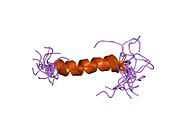Sarcolipin
Template:PBB Sarcolipin is a protein that in humans is encoded by the SLN gene.[1][2]
Function
Sarcoplasmic reticulum Ca2+-ATPases are transmembrane proteins that catalyze the ATP-dependent transport of Ca2+ from the cytosol into the lumen of the sarcoplasmic reticulum in muscle cells. This gene encodes a small proteolipid that regulates several sarcoplasmic reticulum Ca2+-ATPases. The transmembrane protein interacts with Ca2+-ATPases and reduces the accumulation of Ca2+ in the sarcoplasmic reticulum without affecting the rate of ATP hydrolysis.[2]
Ablation of sarcolipin increases atrial Ca2+ transient amplitudes and enhanced atrial contractility. Furthermore, atria from sarcolipin-null mice have blunted response to isoproterenol stimulation, implicating sarcolipin as a mediator of beta-adrenergic responses in atria.[3] Recently it has been shown that SLN is an important mediator of muscle based thermogenesis and loss of sarcolipin predisposes mice to diet-induced obesity thus suggesting its role in energy metabolism and regulation of weight gain [4]
Interactions
SLN (gene) has been shown to interact with PLN[5][6]and ATP2A1.[5][6]
References
- ^ Odermatt A, Taschner PE, Scherer SW, Beatty B, Khanna VK, Cornblath DR, Chaudhry V, Yee WC, Schrank B, Karpati G, Breuning MH, Knoers N, MacLennan DH (Jan 1998). "Characterization of the gene encoding human sarcolipin (SLN), a proteolipid associated with SERCA1: absence of structural mutations in five patients with Brody disease". Genomics. 45 (3): 541–53. doi:10.1006/geno.1997.4967. PMID 9367679.
{{cite journal}}: CS1 maint: multiple names: authors list (link) - ^ a b "Entrez Gene: SLN sarcolipin".
- ^ Babu GJ, Bhupathy P, Timofeyev V, Petrashevskaya NN, Reiser PJ, Chiamvimonvat N, Periasamy M (November 2007). "Ablation of sarcolipin enhances sarcoplasmic reticulum calcium transport and atrial contractility". Proc. Natl. Acad. Sci. U.S.A. 104 (45): 17867–72. doi:10.1073/pnas.0707722104. PMC 2077025. PMID 17971438.
{{cite journal}}: CS1 maint: multiple names: authors list (link) - ^ Bal NC, Maurya SK, Sopariwala DH, Sahoo SK, Gupta SC, Shaikh SA, Pant M et al.: Sarcolipin is a newly identified regulator of muscle-based thermogenesis in mammals. Nat Med, 2012. http://www.nature.com/nm/journal/vaop/ncurrent/full/nm.2897.html
- ^ a b Asahi M, Sugita Y, Kurzydlowski K, De Leon S, Tada M, Toyoshima C, MacLennan DH (April 2003). "Sarcolipin regulates sarco(endo)plasmic reticulum Ca2+-ATPase (SERCA) by binding to transmembrane helices alone or in association with phospholamban". Proc. Natl. Acad. Sci. U.S.A. 100 (9): 5040–5. doi:10.1073/pnas.0330962100. PMC 154294. PMID 12692302.
{{cite journal}}: CS1 maint: multiple names: authors list (link) - ^ a b Asahi M, Kurzydlowski K, Tada M, MacLennan DH (July 2002). "Sarcolipin inhibits polymerization of phospholamban to induce superinhibition of sarco(endo)plasmic reticulum Ca2+-ATPases (SERCAs)". J. Biol. Chem. 277 (30): 26725–8. doi:10.1074/jbc.C200269200. PMID 12032137.
{{cite journal}}: CS1 maint: multiple names: authors list (link) CS1 maint: unflagged free DOI (link)
Further reading
- Lanfranchi G, Muraro T, Caldara F, et al. (1996). "Identification of 4370 expressed sequence tags from a 3'-end-specific cDNA library of human skeletal muscle by DNA sequencing and filter hybridization". Genome Res. 6 (1): 35–42. doi:10.1101/gr.6.1.35. PMID 8681137.
- Odermatt A, Becker S, Khanna VK, et al. (1998). "Sarcolipin regulates the activity of SERCA1, the fast-twitch skeletal muscle sarcoplasmic reticulum Ca2+-ATPase". J. Biol. Chem. 273 (20): 12360–9. doi:10.1074/jbc.273.20.12360. PMID 9575189.
{{cite journal}}: CS1 maint: unflagged free DOI (link) - Smith WS, Broadbridge R, East JM, Lee AG (2002). "Sarcolipin uncouples hydrolysis of ATP from accumulation of Ca2+ by the Ca2+-ATPase of skeletal-muscle sarcoplasmic reticulum". Biochem. J. 361 (Pt 2): 277–86. doi:10.1042/0264-6021:3610277. PMC 1222307. PMID 11772399.
{{cite journal}}: CS1 maint: multiple names: authors list (link) - Mascioni A, Karim C, Barany G, et al. (2002). "Structure and orientation of sarcolipin in lipid environments". Biochemistry. 41 (2): 475–82. doi:10.1021/bi011243m. PMID 11781085.
- Asahi M, Kurzydlowski K, Tada M, MacLennan DH (2002). "Sarcolipin inhibits polymerization of phospholamban to induce superinhibition of sarco(endo)plasmic reticulum Ca2+-ATPases (SERCAs)". J. Biol. Chem. 277 (30): 26725–8. doi:10.1074/jbc.C200269200. PMID 12032137.
{{cite journal}}: CS1 maint: multiple names: authors list (link) CS1 maint: unflagged free DOI (link) - Strausberg RL, Feingold EA, Grouse LH, et al. (2003). "Generation and initial analysis of more than 15,000 full-length human and mouse cDNA sequences". Proc. Natl. Acad. Sci. U.S.A. 99 (26): 16899–903. doi:10.1073/pnas.242603899. PMC 139241. PMID 12477932.
- Minamisawa S, Wang Y, Chen J, et al. (2003). "Atrial chamber-specific expression of sarcolipin is regulated during development and hypertrophic remodeling". J. Biol. Chem. 278 (11): 9570–5. doi:10.1074/jbc.M213132200. PMID 12645548.
{{cite journal}}: CS1 maint: unflagged free DOI (link) - Asahi M, Sugita Y, Kurzydlowski K, et al. (2003). "Sarcolipin regulates sarco(endo)plasmic reticulum Ca2+-ATPase (SERCA) by binding to transmembrane helices alone or in association with phospholamban". Proc. Natl. Acad. Sci. U.S.A. 100 (9): 5040–5. doi:10.1073/pnas.0330962100. PMC 154294. PMID 12692302.
- Suzuki Y, Yamashita R, Shirota M, et al. (2004). "Sequence comparison of human and mouse genes reveals a homologous block structure in the promoter regions". Genome Res. 14 (9): 1711–8. doi:10.1101/gr.2435604. PMC 515316. PMID 15342556.
- Rual JF, Venkatesan K, Hao T, et al. (2005). "Towards a proteome-scale map of the human protein-protein interaction network". Nature. 437 (7062): 1173–8. doi:10.1038/nature04209. PMID 16189514.
- Vittorini S, Storti S, Parri MS, et al. (2007). "SERCA2a, phospholamban, sarcolipin, and ryanodine receptors gene expression in children with congenital heart defects". Mol. Med. 13 (1–2): 105–11. doi:10.2119/2006-00054.Vittorini. PMC 1869624. PMID 17515962.

